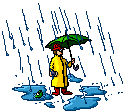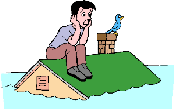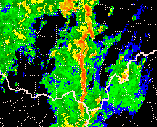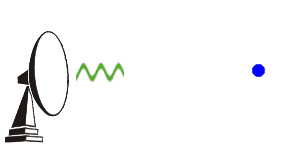How does rain form?
Water droplets form from warm air. As the warm air rises in the sky it cools. Water vapor (invisible water in the air) always exists in our air. Warm air holds quite a bit of water. For example, in the summer it is usually very humid. When enough of these droplets collect together, we see them as clouds. If the clouds are big enough and have enough water droplets, the droplets bang together and form even bigger drops. When the drops get heavy, they fall because of gravity, and you see and feel rain.

What causes rain?
When clouds develop or rain occurs, something is making the air rise. Several things can make this happen. Mountains, low-pressure areas, cold fronts, and even the jet stream.
How big are raindrops?
Raindrops are much smaller than we think! They are actually smaller than a centimeter. Raindrops range from 1/100 inch (.0254 centimeter) to 1/4 inch (.635 centimeter) in diameter.

How fast do raindrops fall?
Not including wind-driven rain, raindrops fall between 7 and 18 miles per hour (3 and 8 meters per second) in still air. The range in speed depends on the the size of the raindrop. Air friction breaks up raindrops when they exceed 18 miles per hour.
What is a flood?
A flood results from days of heavy rain and/or melting snows, when rivers rise and go over their banks.
What is a flash flood?
A flash flood is sudden flooding that occurs when floodwaters rise rapidly with no warning within several hours of an intense rain. They often occur after intense rainfall from slow moving thunderstorms. In narrow canyons and valleys, floodwaters flow faster than on flatter ground and can be quite destructive.
Do flash floods hurt people?
Flash floods are the #1 weather-related killer in the U.S. Nearly 80% of flash flood deaths are auto related. Know beforehand if your area is a flood risk.

How much water is needed for your car to float away?
A mere 2 feet of water can float a large vehicle or even a bus. This is why you should never drive through flooded roads. Just 6 inches of rapidly moving flood water can knock a person down.

What is a monsoon?
A monsoon is a seasonal wind, found especially in Asia that reverses direction between summer and winter and often brings heavy rains. In the summer, a high pressure area lies over the Indian Ocean while a low exists over the Asian continent. The air masses move from the high pressure over the ocean to the low over the continent, bringing moisture-laden air to south Asia. During winter, the process is reversed and a low sits over the Indian Ocean while a high lies over the Tibetan plateau so air flows down the Himalaya and south to the ocean. The migration of trade winds and westerlies also contributes to the monsoons. Smaller monsoons take place in equatorial Africa, northern Australia, and, to a lesser extent, in the southwestern United States.
What is radar?
Radar is an electronic instrument, which determines the direction and distance of objects that reflect radio energy back to the radar site. It stands for Radio Detection and Ranging. This is what meteorologists use to see rain or snow.

What is Doppler Radar?
Doppler Radar detects precipitation intensity, wind direction and speed, and provides estimates of hail size and rainfall amounts. Doppler Radar gives forecasters the capability of providing early detection of severe thunderstorms that may bring strong damaging winds, large hail, heavy rain, and possibly tornadoes. Combined with satellites, radar gives forecasters the ultimate tools to provide accurate forecasts and advanced severe weather warnings.
How does Doppler Radar work?
Doppler Radar gets its name from the Doppler Effect. Have you ever listened to a train whistle as it was coming toward you? You probably noticed that the pitch of the whistle changed as the train passed you and moved away. This change in the frequency of sound is called the Doppler Effect. Doppler Radar measures the changes in the frequency of the signal it receives to determine the wind.

What is NEXRAD Radar?
The National Weather Service has installed a new type of Doppler Radar called NEXRAD Radar. NEXRAD stands for Next Generation Radar. This radar produces many different views of storms and rain that allows meteorologists to determine if a storm could be severe.

 Know the Lingo
Know the Lingo
FLOOD WATCH - means that an overflow of water from a river is possible for your area.
FLASH FLOOD WATCH - means that flash flooding is possible in or close to the watch area. Flash Flood Watches can be put into effect for as long as 12 hours, while heavy rains move into and across the area.
FLOOD WARNING - means flooding conditions are actually occurring in the warning area.
FLASH FLOOD WARNING - means that flash flooding is actually occurring in the warning area. A warning can also be issued as a result of torrential rains, a dam failure or snow thaw.
Click Here to see if there are any active warnings in your area.
 Flood Safety Tips
Flood Safety Tips
BEFORE A FLOOD: Have a disaster plan and prepare a disaster supplies kit for your home and car. Include a first aid kit, canned food, can opener, bottled water, battery-operated radio, flashlight, protective clothing and written instructions on how to turn off electricity, gas, and water.
DURING A FLOOD: Move to a safe area quickly. Move to higher ground, like the highest floor of your home. Avoid areas subject to sudden flooding like low spots and canyons. Avoid already flooded areas. If a flowing stream of water is above your ankles stop, turn around and go the other way. Do not attempt to drive through a flooded road. The depth of the water is not obvious and the road may be washed away. If your car stalls, leave it and seek higher ground. Rapidly rising water may engulf the car, pick it up and sweep it away. Kids should never play around high water, storm drains or viaducts. Be cautious at night, because its harder to see flood dangers. If told to evacuate, do so immediately.
AFTER THE FLOOD: Always, boil drinking water. Electrical equipment should be checked and dried before used.
 Rain Activities
Rain Activities
Lesson Plan: Here is a great lesson plan on learning about precipitation. In this activity, kids will use a weather map to answer questions about precipitation falling across the country. Note: This is a PDF file, so you need to have Adobe Acrobat Reader.
Rain Experiment: Here is a great experiment on making rain. In this experiment, kids learn about condensation.
Rain Experiment: Here is an experiment that lets kids see what's in the rain. It shows kids that there are particles in the air and when it rains they get to see them up close.
Rain Gauge Experiment: Here is an experiment that allows a kids to make their very own rain gauge.
Raindrop Experiment: Here is an experiment that allows you to see a raindrop. In this experiment, kids will preserve raindrops, so they can measure to see how big they really are.
Watercycle Experiment: Here is an experiment that teaches kids about our water cycle. This experiment shows what happens to the water in our creeks, streams, rivers, lakes and oceans.
The Doppler Effect Experiment: Here is an experiment that teaches kids what the Doppler Effect is. They can learn how the Doppler Effect works and why Doppler Radar is such as important tool in weather forecasting.
Pressure Experiment: Here is an experiment that shows how pressure is created in our atmosphere by sucking an egg in a bottle. This is a very cool experiment!
Make A Barometer Experiment: Here is an experiment that allows the kids to make a barometer.
Evaporation Experiment: Here is an experiment that shows kids how evaporation takes place.
Science Fair Project Ideas: Here is a complete list of science fair project ideas. Discover the science behind the weather that impacts us every day.